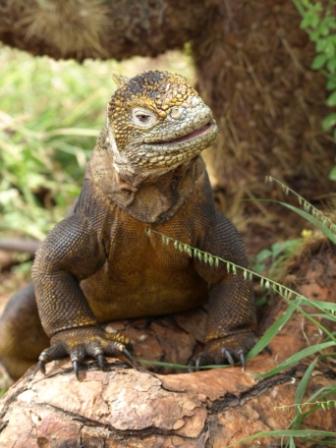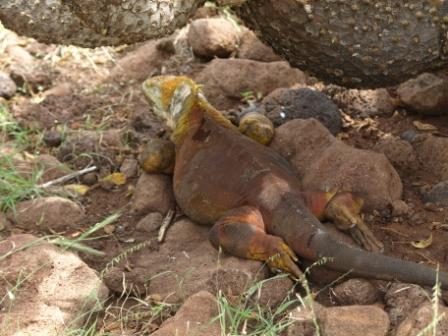The enigmatic iguanas

VulcanSpirit
Richard & Alison Brunstrom
Mon 16 Apr 2012 04:41
This is a long and exciting (to me anyway) story of biogeography and evolution, which is what the Galapagos are all about. But of course if that's not your thing you can skip it and just look at the pictures.
There are two closely related types of iguana here - terrestrial and marine. Marine iguanas are unknown anywhere else in the world - they must have evolved here. The iguanas must have arrived here as land iguanas on floating vegetation (the ocean currents are ideal) from South America in the same way that their relatives colonised the Caribbean, and divereged into the marine and terrestrial forms after arrival.
But there is a problem with this scenario. The Galapagos are very recent islands in geological terms. They are are volcanic, made of lava and ash from volcanic eruptions. The oldest rocks here are about 2 million years old, although it is suspected that some of the islands may be up to 5 million years old (for reasons that I don't undertand it is very difficult to precisely age buried lava).
However, according to recent DNA studies the last common ancestor of the two iguanas here lived at least 11 million years ago. The only explanation is that they must have arrived onto different islands, now disappeared, and colonised the currently existing islands from there as they rose from the sea to the west.
This is possible. The Galapagos islands sit over a hotspot and are on a moving plate travelling slowly towards South America. The most recent islands are to the west, the oldest to the east. Further east still are shallows which may represent submerged earlier islands - it seems that as the islands move east the earth's crust upon which they sit cools down as it gets further away from the hotspot. As it does so it contracts and the island upon it sinks below the waves (aided by coastal erosion).
And the iguanas are still moving west. The most recent island, Fernandina, is only a few hundred thousand years old and is still actively growing. But it has land iguanas.
There are two species of land iguana - or there were until 2009. To everyone's surprise there are now three. And a further series of enigmas.
Most islands but not all have or had (human activity has rendered them extinct on a couple of islands) the yellow iguana, Conolophus subcristatus. Here is one on the island of Seymour Norte:

This is a big male well over a metre long. It is vegetarian. Here is another, looking for trouble - they are very territorial and the males fight regularly though not much damage is done. More a trial of strength:

And here is a big fat healthy one crashhed out under an Opuntia (prickly pear) tree looking very yellow:

Botanists may sit up and take notice here. Uniquely in Galapagos the Opuntia cactuses have become trees up to 15 metres tall. And they have evolved into several different species - see a later Blog. Here it's providing some much needed shade for a very hot iguana.
It is very odd that despite 11 million years having passed there has been no further diversification of the land and marine iguanas in Galapagos, until the Pleistocene (i.e. quite recently). Since then the Santa Fe island land iguana Conolophus pallidus has evolved on its own small island, probably as a result of a small group getting isolated during sea level changes (genetic drift leading to speciation is much easier in small gene pools). I've no picture of it because we didn't manage to get there but there are lots on the internet for those just desparate for more lizard pictures.
So that's two. But then the Galapagos pink iguana was described in 2009, now called Conolophus marthae. Again see Internet for lovely pictures. It is quite extraordinary that a large bright pink iguana could be discovered in one of the most studied places in the world in 2009 but that's what happened. This turned out to be another enigma. It lives exclusively on Wolf volcano on Isabela Island. The volcano is less than 350 000 years old. This means that this lizard colonised Isabela very recently, within the last 500-300 000 years. But from where?
But then the mystery deepened. DNA analysis showed that, without doubt, the pink iguana is ancestral to all other Galapagos land iguanas. The most likely explanation is that it colonised Isabela from another, existing, Galapagos island from where it has subsequently gone extinct. And it has gone extinct on all other islands too. It cannot have died out from competition with the yellow iguana - both live together on Wolf. There are no records of pink iguanas anywhere else so the mystery is currently not solved. Rabida Island is a possibility (iguanas went extinct there before humans arrived), but why the ancestral pink form survived on Isabela and nowhere else is unknown.
The marine iguanas are another story, for another Blog. And I've still got to deal with the Opuntias, the tortoises (the Galapagos tortoises are the world's largest) about which there have very recently been extraordinary developments, and of course Darwin's famous finches and mockingbirds which spurred the development of his ideas on the origin of species - one of mankind's greastest intellectual achievements. And a few more pretty animal pictures.
And we've relearnt to dive after a 25 year gap, so there are underwater shots to come too. I can heartily recommend diving with sealions.